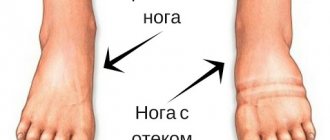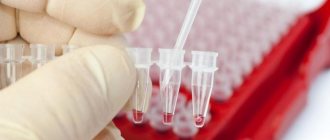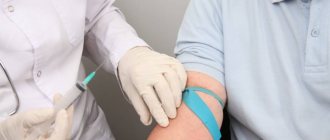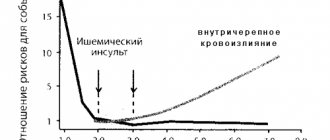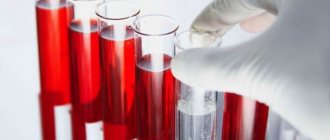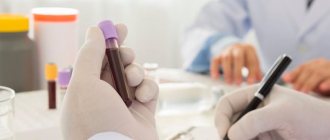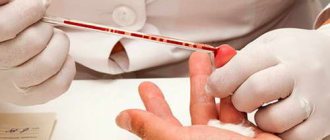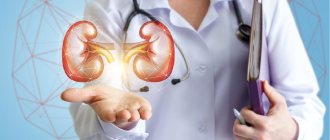What is creatinine?
Creatinine is one of the metabolites of biochemical reactions of amino acid-protein metabolism in the body. The formation of this compound occurs constantly and is associated with metabolic processes in muscle tissue. Since muscles constitute one of the main masses of the human body, and contraction requires a constant energy substrate, powerful energy carriers must be embedded in their structure. This is necessary in order to meet emergency energy needs.
The main donor of ATP for muscle tissue is creatine phosphate - the phosphorylated essential amino acid creatine. After synthesis in the liver, it enters the muscles, where it is dephosphorylated by the enzyme creatine phosphokinase. The result of these processes is the formation of energy and creatinine. ATP is used by the muscles to meet energy needs, and the kidneys excrete creatinine in the urine after filtration.
Creatinine, as the final product of breakdown reactions, is not consumed in the body for other metabolic processes. This is a compound that is harmful to tissues and should be eliminated from the body as much as possible. Violation of creatinine metabolism can occur at the stages of its intake, metabolism and excretion!
Normal creatinine
All creatinine cannot be filtered and excreted by the kidneys. This is due to the fact that it is constantly released into the blood while the muscle tissue is viable. Blood plasma should contain a relatively stable concentration of creatinine, which may vary depending on age, muscle activity and nutrition. Therefore, there are maximum and minimum limits of normal creatinine, which take into account all these points and indicate the normal functioning of organs.
To eliminate errors in the results of a biochemical blood test based on creatinine levels, be sure to adhere to the general rules for blood sampling. The study must be carried out in the morning on an empty stomach. It is advisable to avoid strong muscle strain and overheating or hypothermia before directly drawing blood.
To illustrate the variations in creatinine standards, they are presented in table form:
| Age and gender | Small children | Pupils | Men | Women |
| Creatinine norm in µmol/l | 45-105 | 27-62 | 74-110 | 44-80 |
Creatinine norm in women
Plasma creatinine concentrations in women should be lower than in men. This is due to the physiological mechanisms of its formation, distribution and circulation in the blood.
The mechanisms of this phenomenon are as follows:
- A woman's muscle mass is less than that of a man;
- Less muscle strain;
- The activity of metabolic processes in the female body is reduced;
- Food products from the female diet contain less exogenous creatinine entering the body;
- The influence of sex hormones and pregnancy.
Creatinine norm in men
The creatinine of the male body should almost always be higher than that of women of the same age group. This is due to lifestyle characteristics and differences in the functioning of organs and systems. Age characteristics also affect the process of creatinine metabolism, both towards its increase and decrease. Recently, many men have been visiting gyms and using doping products containing creatine to increase muscle performance. This must be taken into account when assessing the creatinine norm.
Normal creatinine level in children
The concentration of creatinine in a child’s plasma largely depends on his age. The main fluctuations in this indicator are associated with growth activity and the degree of increase in muscle mass over a certain period of time. Newborns, due to the high stress that their body had to experience during childbirth, have creatinine levels the same as in adults. The same feature is typical for adolescents, which is explained by the active growth of the body. School-age children grow relatively steadily, so their creatinine levels are slightly lower than adults.
Complexes with this research
Expanded hospital complex Expanded infectious screening for prevention and hospitalization 4,150 ₽ Composition
Pregnancy planning. Clinical indicators 3,470 ₽ Composition
Women's check-up No. 1 38 studies for annual preventive examination 11,260 ₽ Composition
IN OTHER COMPLEXES
- Kidneys. Extended examination 1,050 ₽
- Biochemistry of blood. 8 indicators 990 ₽
- Fitness control of sports nutrition RUB 2,780
- Female infertility RUB 9,210
- Examination during pregnancy. 3rd trimester 5 150 ₽
Elevated creatinine levels
When assessing creatinine metabolism, most often one has to deal with an increase in the concentration of this metabolite. It is very important to correctly interpret the obtained indicators, taking into account the possibility of physiological and pathological increases, age and gender standards. The condition in which an increase in plasma creatinine is recorded is called hypercreatinemia.
Hypercreatininemia does not cause severe abnormalities in the body, since creatinine itself is low-toxic. Its harmful effects on tissue can only appear with sharp deviations from the norm in its concentration. This metabolite is more related to the consequences of various conditions and diseases, signaling their presence. Therefore, isolated hypercreatininemia causes virtually no symptoms.
It is usually combined with other pathological symptoms that may suggest the need for this study:
- Muscle pain;
- Fatigue and muscle weakness;
- Edema;
- An increase or sharp decrease in the amount of daily urine;
- Pathological changes in general urine analysis (protein, leukocytes, erythrocytes).
The pathogenesis of hypercreatinemia can be associated with any of the stages of creatinine metabolism and circulation in the body. It can be influenced by the nature of the diet, the mode of physical activity, the amount of fluid consumed, the use of medications, the anatomical features of muscle tissue and its condition, the functional abilities of the excretory system and liver.
What does elevated creatinine mean?
An increase in creatinine concentration during a biochemical blood test may indicate:
- Increased intake of creatine-containing substances into the body from the environment with increased protein nutrition;
- Excessive or very rapid increase in muscle mass;
- High loads performed by muscles;
- Destruction of muscle tissue;
- Redistribution of blood and disruption of water balance in the body;
- Impaired kidney function in neutralizing and excreting creatinine;
- Toxic effects on the body;
- Endocrine disorders that regulate metabolic processes in the body.
In some cases, one has to deal with a relative increase in creatinine levels, which does not occur due to its excess production or retention in the body. It is associated with a decrease in the volume of circulating plasma as a result of its redistribution, blood loss or dehydration. Relative hypercreatininemia is combined with other signs of hemoconcentration and blood thickening, which helps in its correct assessment. It never reaches large values.
An increase in creatinine levels can be physiological, not due to disease, or pathological. In the second case, the main cause of hypercreatinemia is renal failure in any type of kidney damage, in which creatinine numbers can increase several times. Physiological hypercreatinemia can never be represented by a large deviation from the norm!
Causes of elevated creatinine
The immediate causes of hypercreatinemia, taking into account the severity of the increase in creatinine, are presented in the table.
| Pathological causes of increased creatinine | Physiological reasons for increased creatinine | |
| Moderate hypercreatinemia | Severe hypercreatinemia | |
|
|
|
How to reduce creatinine in the blood?
After a detailed examination and clarification of the cause of hypercreatinemia, the following recommendations can be given:
- Hospitalization in medical institutions according to the profile in case of detection of diseases. These may be general therapeutic hospitals and specialized departments for the treatment of renal or other types of pathology;
- Taking medications to normalize protein metabolism and remove toxic products of protein metabolism;
- Normalization of water metabolism by selecting optimal volumes of fluid consumed for a particular case, taking into account the capabilities of the kidneys. If hypercreatinemia is caused by physiological mechanisms, then an increase in the daily volume of pure high-quality water will lead to a decrease in the concentration of creatinine and will accelerate its excretion by the kidneys;
- Normalization of diet in qualitative and quantitative terms. It involves the complete exclusion or limitation of the consumption of protein foods and salt, which contribute to an increase in nitrogen compounds or retain fluid in tissues. This, in addition to the absolute increase in creatinine, causes its relative increase due to hemoconcentration;
- Correction of lifestyle and physical activity. They must be brought into line with the actual capabilities of the body. If no pathological causes of increased creatinine have been identified and the only option for this condition is excessive physical activity, they should be reduced as much as possible;
- Extracorporeal detoxification procedures (hemodialysis and its analogues). The use of an artificial kidney is advisable only for severe types of hypercreatinemia caused by decompensated renal pathology or intoxication.
Under no circumstances should you even try to cope with elevated creatinine levels in the blood on your own. This symptom may be the small tip of a large iceberg of illness. Any corrective and therapeutic measures must be supervised by a specialist!
Diet for high creatinine
One of the most important measures to reduce creatinine levels is diet therapy. Its general characteristics include limiting the consumption of protein foods, salt and potassium, enriching the diet with antioxidants and foods that cleanse the body.
Excluded:
- Fatty varieties of animal and poultry meat (pork, duck, goose);
- Fatty fish;
- Whole milk;
- Spicy dishes and spices;
- Coffee and strong tea;
- Dishes made from rich yeast dough;
- Fried foods and smoked meats.
Limited to:
- Dietary meats (chicken, rabbit, turkey, young beef). You can introduce meat days twice a week, when they are included in small quantities in dishes;
- Eggs – up to 2-3 per week;
- Fish. Fish days are organized by analogy with meat days;
- Salt and sugar. With a pronounced increase in creatinine, they are completely excluded;
Recommended:
- Fresh or boiled vegetables and fruits in any quantity;
- Berries, fruit drinks and compotes based on them;
- Nuts and dried fruits. They are limited or completely eliminated only in case of renal failure, when the potassium level is sharply increased;
- Fermented milk products (yogurt, kefir, fermented baked milk);
- Cheese and cottage cheese;
- Butter and vegetable oil;
- Cereals and porridges based on them. Rice is especially useful in this regard;
- Wholemeal bread with added bran and pasta;
- Honey;
- Mineral and purified plain water at least one liter per day. Water loads are minimized only in cases of renal failure.
- Allowed dishes:
- Boiled;
- Steamed;
- Stewed;
- In the form of soup, puree, cream soup, salad, jelly, porridge, casseroles, cutlets, meatballs;
Additional important recommendations: scientific arguments
- Reduce your consumption of red meat.
Research shows that eating large amounts of red meat may increase creatinine levels, at least temporarily. If you eat a lot of red meat, switch to vegetable dishes [1].
- More fiber.
Eating more fiber-rich foods can also help reduce creatinine. For example, a 2014 study published in the European Journal of Clinical Nutrition found a significant reduction in creatinine levels in 143 participants with chronic kidney disease who increased their dietary fiber intake [2]. (on the topic: fiber: benefits, types + TOP products).
- Additives with chitosan.
A 2011 study published in the Journal of Pharmacy and Pharmacology examined the effects of chitosan on 80 patients with kidney failure. Half of the patients were given chitosan three times daily in tablet form, which resulted in a significant reduction in creatinine levels after 4 weeks compared to control patients [3].
Interpretation of results
For patients of different gender and age, their own reference values have been established. When interpreting the results, the amount of muscle mass, level of physical activity and other factors are also taken into account. With age, uric acid concentrations decrease as creatinine synthesis in the kidneys changes. The research can be carried out by fermentation or chemical methods.
Based on the test results, diseases of the kidneys, thyroid gland, skeletal muscles, intestinal obstruction and other pathologies are detected. Increased performance is also characteristic of serious muscle injury. Decreased levels may indicate insufficient physical activity or lack of nutrition. In most cases, the results of one test are not enough for accurate diagnosis and selection of effective treatment methods. If deviations from the norm are detected, a comprehensive examination is prescribed. When diagnosing, the results of all examinations are taken into account. This makes it possible to avoid mistakes, quickly make an accurate diagnosis and begin treatment. It must be taken into account that sometimes in the presence of renal failure, indicators remain within normal limits for several years.
Creatinine decreased
Conditions in which a decrease in plasma creatinine levels is recorded are extremely rare. Their appearance indicates a disruption of metabolic processes, accompanied by profound disorders of protein metabolism in the body in general, or isolated in muscle tissue. If hypercreatinemia mainly depends on the functional capacity of the kidneys, then in the case of hypocreatinemia (decrease in creatinine level), their condition does not play a role. Consequently, the main mechanism should be such a depletion of energy reserves in the body that protein resources, which are most abundant in the muscles, are used to repay them. A decrease in creatine phosphate reserves naturally leads to a decrease in the concentration of its metabolites in the blood, which is creatinine.
Indications for the study
Most often, a blood test for creatinine is prescribed if kidney problems are suspected. Also, its results are used to assess the condition of the entire urinary system as a whole. The study is prescribed if drug therapy is planned that poses a potential danger to the kidneys. Healthy people who actively engage in sports and build muscle volume also need to monitor their performance. This is also important for those who follow a protein diet. The analysis can be prescribed during a preventive examination or diagnosis of diseases, independently or in combination with other studies.
